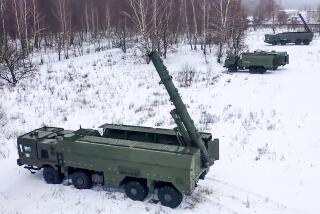A New Nuclear Age
SOUTH POMFRET, Vt. — The Pentagon’s Nuclear Posture Review, approved by President Bush in January 2002, outlined steps the U.S. should take to ensure its future ability to “defeat any aggressor.” Included was a mandate for an “assured, survivable and enduring” communications network, one that would remain functional even after a full-scale nuclear attack.
Defense Department documents recently made available to the Los Angeles Times describe how the government is now moving ahead with a number of new programs toward that end, including a $200-million, eight-year effort to expand and streamline nuclear war planning. Concurrently, the same commercial technologies used in wireless communications and personal computing are being enlisted to achieve a long-standing nuclear war fighter’s dream: systems able to operate even during a protracted nuclear war.
According to classified and unclassified briefing and contracting documents, the modernization efforts seek to make existing nuclear war planning systems “more flexible and adaptable on all fronts.” The new focus increases the “number of threat countries” included in nuclear war planning and expands the types of targets to be considered. The plans also envision an expanded role for both special operations and cyber- warfare in the event of a full-scale nuclear war. New software tools are being developed to speed up the time it takes U.S. Strategic Command to prepare nuclear options for the president, the secretary of Defense and the Joint Chiefs of Staff.
In May, Northrop Grumman Mission Systems and Lockheed Martin Mission Systems were awarded contracts to begin designing the new planning tools envisioned in the Nuclear Posture Review. According to military documents, they are needed because “the current process has no growth capability to handle the increasing target requests, which are projected to grow tenfold by 2007.”
When the eight-year program is complete, key nuclear commanders and civilian decision-makers will not only have a “point-and-click” interface for planning nuclear war; they will also have a new array of specially configured laptops, cell phones and other electronic gear to streamline a variety of tasks.
New communications systems aimed at maintaining presidential control over nuclear forces are also being developed and deployed. The most important, known by the acronym GEMS, will modernize the current systems that handle transmission of nuclear “go codes,” or orders from the president to launch a nuclear attack. The update will allow for greater capacity and quicker transmission of information and intelligence.
Utilizing highly automated systems and new, higher-bandwidth satellites, military planners expect to be able to still function even after a nuclear attack. The systems will incorporate such things as secure video teleconferencing and voice recognition software to ensure security. A constellation of up to five advanced satellites costing more than $400 million apiece will be launched into orbit beginning in 2006 to enable secure communications between the president and the country’s nuclear forces.
The expanded communications systems will have both fixed and mobile communications terminals in at least 31 states and seven foreign countries, as well as at numerous classified sites, according to military documents. Terminals will be placed in military headquarters, at missile launch sites, on bombers and other aircraft supporting nuclear warfare and on submarines and support ships. When fully operational in 2010, the system will provide “survivable” terminals to connect underground nuclear command centers and nuclear forces. Even the paging devices of bomber crews on nuclear alert will be connected to the system.
But the real innovation is the 69 “transportable terminals” small enough to be set up, operated and maintained by one person. These communications terminals will be designed to “reliably operate in pre- through post-nuclear environments,” according to an official “statement of objectives” for the project. A December 2002 “operational requirements document” outlines how, as tension levels increase, mobile support teams would be sent with these terminals to secret locations. In the event of nuclear war, the mobile teams would restaff command posts, bombers and tankers. They would rendezvous with submarines and transport new nuclear weapons to surviving units capable of delivering them.
The new systems are just one part of the military’s implementation of the more aggressive nuclear war strategies laid out in the Nuclear Posture Review. In June 2002, the Navy and the Air Force rolled out a new system that would allow for the reception of emergency messages during or after a nuclear attack even if other communications systems had failed. Because the system operates on a low frequency, it is slow, but that also means it isn’t subject to the same disruptions from electromagnetic pulses that could interrupt most other systems after a nuclear explosion.
Some of the technology that will soon be employed in implementing the Nuclear Posture Review’s mandates is not new. One system, designed to allow the transmission of encoded “emergency actions messages,” employs new Windows-like software and “open architecture networking.” It initially came into use in August 2001, and proved so valuable on and after Sept. 11 that the Air Force notified the defense industry last month that it is looking at procuring an additional 200 or more of the systems in the future.
Sept. 11 also served as the spark for communications network improvements at the presidential level. The White House has initiated a highly classified “Pioneer” project to resolve deficiencies in presidential communications revealed after the World Trade Center and Pentagon attacks. “The events of Sept. 11, 2001, illustrate the need to improve our national command and control architecture,” Adm. James O. Ellis Jr., commander of Strategic Command, told Congress in April. Military planners and government agencies, he added, were working to craft a new national system to rectify the problems.
The military is clearly moving quickly to implement the Nuclear Posture Review’s recommendations. Some of the upgrades are no-brainers: If we are going to possess nuclear weapons, the need to maintain civilian communications with nuclear forces even in the most catastrophic circumstances is indisputable. The new technologies will enable greater mobility and faster decision making. Let’s hope that in doing so, they don’t also increase the likelihood that the U.S. will initiate a nuclear war.
More to Read
Sign up for Essential California
The most important California stories and recommendations in your inbox every morning.
You may occasionally receive promotional content from the Los Angeles Times.










